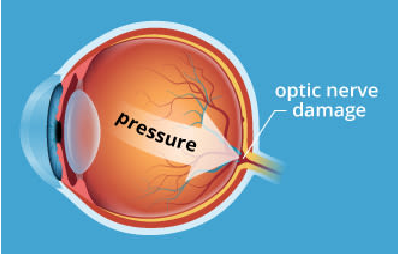
What is glaucoma?
Glaucoma is defined as a group of eye conditions that can damage your optic nerves, the information pathways between the eyes and brain.
Glaucoma is almost always caused by too much pressure inside one or both eyes. Once this pressure starts to affect the optic nerve, it can lead to irreversible levels of blindness.
People don’t typically experience symptoms until the optic nerve has already been damaged. Scheduling regular eye exams helps doctors catch eye pressure or optic nerve problems before vision loss occurs or worsens.
Glaucoma usually occurs later in life, but it can happen at any age. Certain populations are at greater risk of glaucoma than other populations, but glaucoma affects all races.
If you’re diagnosed with elevated eye pressure or glaucoma, don’t panic. With routine check-ups and modern treatment, most patients have a good outlook toward keeping the vision they have.
Optometrists are trained to spot the early warning signs of glaucoma before vision loss occurs.
NEED AN EYE EXAM? Contact us and make an appointment today.
What causes glaucoma?
Our eyes are filled with a fluid called aqueous humor that gives them their round shape. In a normal eye, the fluid filters in and out easily.
Sometimes fluid doesn’t flow out as easily as it flows in. When too much fluid builds up inside the eye, it causes internal eye pressure, called intraocular pressure or IOP, to go up.
Eye pressure that’s higher than the normal range is known as ocular hypertension. People with ocular hypertension but no signs of glaucoma are called glaucoma suspects.
The most common type of glaucoma occurs when intraocular pressure is too high for too long. This puts outward pressure on the inner walls of the eye, eventually damaging the optic nerve that connects in the back of the eye.
Eye pressure can be raised for several years before optic nerve damage starts to affect your eyesight. The early detection and treatment of high eye pressure are the keys to successful glaucoma prevention.
Several things can cause high eye pressure and glaucoma:
- Family history of glaucoma
- Hereditary predisposition to glaucoma
- Underlying conditions like diabetes or high blood pressure
- Regular use of certain medications, including steroids
- Eye injury or trauma
- Thin corneas (the clear layer in front of your pupils)
- Extreme nearsightedness
Sometimes, glaucoma doesn’t have a direct cause.
There are four main types of glaucoma. The most common type is open-angle glaucoma, when untreated long-term pressure causes damage to the optic nerve.
Less often, glaucoma can occur in someone with normal eye pressure. This is called normal-tension glaucoma, but some doctors label it as a slower version of open-angle glaucoma.
Narrow-angle glaucoma (also called closed-angle or angle-closure glaucoma) comes on suddenly, either as a result of injury or illness, or without any reason at all. It requires immediate medical treatment to save a patient’s vision.
Secondary glaucoma is caused by a separate illness or condition. There are many forms of secondary glaucoma; each can come in either open-angle or narrow-angle form.
Developmental glaucoma (also called childhood or pediatric glaucoma) may be present from birth or caused by an injury or underlying condition and is usually diagnosed at a young age.
Glaucoma symptoms
While the more common open-angle glaucoma typically does not cause any symptoms until vision loss occurs, usually in your side (peripheral) vision.
However, narrow-angle glaucoma does cause symptoms. These can include:
- Intense eye pain and/or headache that comes on quickly
- Nausea
- Vomiting
- Blurry vision
If you think you have narrow-angle glaucoma, get emergency treatment right away.
